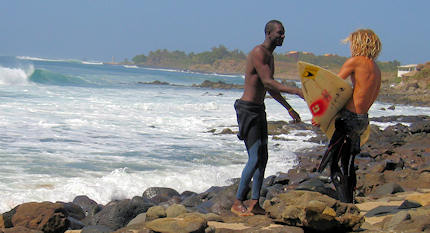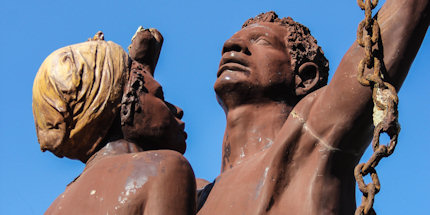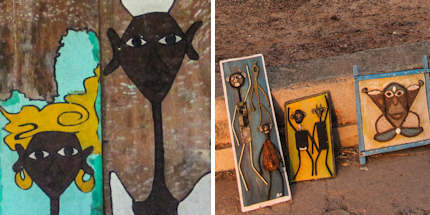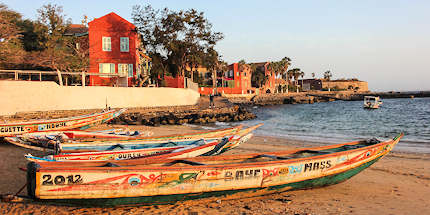Senegal: A shortcut to the tropics
From beaches and birdwatching to hedonism and history, Europeans are falling for Senegal’s many charms, as Gavin Haines did while discovering the diverse West African nation at first hand.
Senegal might have gained independence in 1960, but its palm-fringed beaches continue to be colonised by the French. And who can blame them? With direct flights between Paris and Dakar taking just five and a half hours, Senegal is a shortcut to the tropics for French travellers.
However, the appeal of this West African nation is becoming wider, with ever-increasing crowds of Europeans being lured to its shores. They’re not just coming for the beautiful beaches; this is a country of extreme variety, where you can surf all day, party all night and immerse yourself in the arts. It’s also home to one of the most biodiverse ecosystems on the planet.
Surf in the city
As my taxi trundles through another traffic jam in the Senegalese capital, surfers walk past with boards under their arms bound for Dakar’s golden beaches, where perfect breaks roll in from the Atlantic with Swiss watch regularity.
 Ride the waves along Dakar's coast
Ride the waves along Dakar's coastCreative Commons / Manuele Zunelli
With my patience for traffic running out, I jump out of the taxi at Plage N’Gor, one of the best spots for wave riding in Dakar, and watch surfers scythe through the swell – no wonder this country was chosen as a location for seminal surf film The Endless Summer.
There are waves for all abilities, but if you need help catching them, drop by at a local surf school. N'Gor Island Surf Camp is particularly popular thanks to its idyllic location on Île de N’Gor, a small island to the north of the city.
After a hard day in the water, sun-kissed surfers join the party in Dakar. It’s a hedonistic city, which is surprising considering its isolated location and largely Islamic inhabitants: mosques abound and the call to prayer echoes around the streets. It’s a startling contrast to the raucous nightlife of Les Almadies and N’Gor – where you can find anything from live jazz to vinyl-spinning DJs – that doesn’t warm up until midnight.
Uncover horrible histories
Although modern Dakar is a liberal, multicultural metropolis, it wasn’t always this way as a trip to Île de Gorée reveals. This beautiful island is a 20-minute ferry ride from the Senegalese capital, but you’d swear you were in a different country; there are no cars here and the sandy streets are lined with magnificent colonial-era buildings. These 17th-century townhouses were constructed by Dutch imperialists before the French came along.
 A monument at La Maison des Esclaves, Île de Gorée
A monument at La Maison des Esclaves, Île de GoréeWTG / Gavin Haines
There’s a village feel to Île de Gorée; kids play in the streets, neighbours chat in doorways and enormous pelicans skulk around like the local mafia. But behind this idyllic scene is a grim history that's laid bare at La Maison des Esclaves (The House of Slaves). This former slave house tells the story of the island’s role in the slave trade, which saw European raiding parties land on the shores of West Africa, round up indigenous tribes and bring them here, before sending them off to colonies in America.
“This is the door of no return,” explains my guide, as we look out to the Atlantic Ocean. “They loaded slaves onto the ships here and they never came back.” The barbarity is hard to contemplate.
Discover a burgeoning arts scene
A visit to the island’s castle is altogether cheerier. Constructed by the Dutch to defend the island (it failed), the citadel sits atop a small hill on Île de Gorée and is home to local artists who ply their trade through vibrant paintings and sculptures.
 Artwork at Village des Arts and Île de Gorée Castle
Artwork at Village des Arts and Île de Gorée CastleWTG / Gavin Haines
This is a great spot to buy souvenirs but if you have a penchant for art, you should head to the Village des Arts in Dakar. Constructed to house Chinese immigrant workers, it’s now home to 50 artists in residence who display their work in the on-site gallery. “This is a place where artists can come to exchange ideas and express themselves,” explains resident artist Elsy as we walk around the gallery. “We have an exhibition here every day.”
Unwind on unspoilt beaches
Leaving the streets of Dakar behind, I head 60km (37 miles) south to the seaside town of Mbour. Arriving at the beach, I’m greeted by horses rolling in the sand, men wrestling (it’s the number one sport here) and kids playing football.
Mbour nestles idyllically on Senegal’s Petite Côte, which is lauded for its palm-fringed sands and azure waters. This small fishing town is a quieter and prettier alternative to nearby Saly, which has become something of a tourist town in recent years.
 Pirogues on the beach at Île de Gorée
Pirogues on the beach at Île de GoréeWTG / Gavin Haines
It’s well worth heading to the main beach one afternoon where hundreds of pirogues bring in an iridescent mix of barracuda, marlin and much more. Mbour is the region’s most important fishing centre and the beachfront restaurant at Tama Lodge does the local produce justice; chefs rustle up fantastic seafood dishes, which vary depending on the day's catch.
Explore the Saloum Delta
The Petite Côte beaches are fabulous but nothing compares to the beauty of the Saloum Delta, which is characterised by dense mangroves, tropical forests and some of the most exquisite birdlife on the planet – so much so, this protected area was added to the list of UNESCO World Heritage Sites in 2011.
 Find abundant bird life in the Saloum Delta
Find abundant bird life in the Saloum DeltaHemera / Thinkstock
Floating with the current aboard a hydro bike hired from the bijou Les Palétuviers resort, which nestles on the delta’s edge in Toubakouta village, I see fish display their kaleidoscopic scales as they jump from the water – a dangerous game as Goliath herons, kingfishers and pink-backed pelicans stalk the shallows and skulk in the mangroves waiting for their next meal.
The Saloum Delta has also sustained human life for more than two millennia. The fishing and harvesting of shellfish have been integral to the survival of locals who have shaped the landscape with their appetite for seafood; manmade spits and small islands have been created in the delta using millions of empty shells. The best example of this can be found at Fadiouth, a gorgeous little community built on an island made entirely of empty shells – it's the most beautiful paradigm of land reclamation I have ever seen.
DETAILS
Getting there:
There are no direct flights between the UK and Senegal but Air France operates flights via Paris from £524.
The Senegal Experience (tel: 0845 330 2080 from the UK; www.senegal.co.uk) offers seven-night packages in the Saloum Delta from £899. Packages include half-board accommodation at the Keur Saloum Hotel (based on two sharing), direct return flights from London Gatwick Airport to neighbouring Gambia and local transfers. Price based on a departure date of 26 November 2013.
When to visit:
November to May is the most pleasant time to visit where climate is concerned. Mosquitoes can be intolerable and roads have been known to wash away in the rainy season (June to October).
Do you have any Feedback about this page?
© 2025 Columbus Travel Media Ltd. All rights reserved. No part of this site may be reproduced without our written permission, click here for information on Columbus Content Solutions.









 You know where
You know where